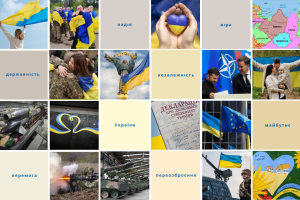How Ukrainians evaluate education during pandemic
The national survey “Opinions and views of Ukrainian population” conducted by the Kyiv International Institute of Sociology as ordered by Democratic Initiatives Foundation in May-June 2021. 2003 respondents, over 18 years of age each have surveyed across all regions of Ukraine except Crimea AR and certain regions of Donetsk and Luhansk oblasts. The interviews were conducted using the CATI method and represent respondents according to sex, age, macro region of residence, type of settlement. Statistical margin of error (with 0.95 probability rate and design-effect of 1.1):
2.4% for indicators close to 50%
2.1% for indicators close to 25 or 75%
1.5% for indicators close to 10 or 90%
1.1% for indicators close to 5 or 95%
0.5% for indicators close to 1 or 99%
The citizens assess secondary education in Ukraine between low and medium quality. However, in comparison with poll conducted in July 2020, the share of negative responses has risen by 9%, in part due to increase in number of people giving Ukrainian education bad rates. In 2021, 45% of Ukrainians have graded Ukrainian secondary education as low quality, 44% more call it medium .
Traditionally, the secondary education has received the least negative grades from the residents of the western regions, although their grades have been getting consistently lower. The educational system is more appreciated by the respondents aged 18-29 years, those who have recently graduated from schools – 14% have graded the educations quality as very high. The lowest grades come from the oldest age group – 60+ years – only 4% have positively graded the quality of education.
The absolute majority (65%) of parents are against online education. 50% of the families whose children or grandchildren attend school agreed that introduction of the online education has, in one way or another, safeguarded their family from potential contact with COVID-19; however, 56% reported that the difficulties prevailed over the benefits.
Analysis of the survey data produced several observations:
In the urban areas and cities with population over 500,000 people expressed higher support for the online education than in other types of settlements. Meanwhile, respondents from the rural areas are the biggest opponents (72%) of the online education.
Residents of Donbas (79%), eastern (60%), and southern regions (59%) of Ukraine expressed concerns about different aspects of the online education.
The most common concerns about online education are: decrease in academic success (72%), lack of teacher’s attention to students needs during classes (51%) and a very formal approach to performing online education (50%). Families from the different regions of Ukraine contracted different hardships on their kids’ way of attaining secondary education. Parents from the western and southern regions more often than others have reported poor domestic internet connection during the classes. Their Donbas counterparts, besides children’s’ decreased academic success, have often admitted the issue of using various messengers and online-platforms for children’s’ communication with a teacher (47%) and deficit of necessary devices for participation in the online classes (44%).
Parents from the rural areas reported about deficit of necessary devices for participation in the online classes: 53% have pointed out exactly this problem, in comparison to the 20% in the big cities (over 500,000 residents). Similarly, parents living in the villages have, more often, complained about a bad quality of internet connection (60% against 29% in the urban areas) and the problem of using different messengers and online platforms for communication (51% against 33% in the urban areas).
Mothers and grandmothers, as opposed to fathers and grandfathers, reported more often about poor quality of internet connection and lack of communication devices. This difference could be explained by the fact that women tend to spend more time looking after the children and during online lessons, which makes them more informed of the technical issues showing up during the lesson.
Despite the fact that the children did not attend schools for a long time, 48% of all parents reported that monetary “donations” for the school or the class unofficial funds remained the same and 8% said that such payments increased. 13% of Ukrainians from the southern regions reported about increased “donations”. Only 5% of all parents refused to pay such “donations”, 21% stated they never paid them.
One of the indirect negative consequences of online education was increase of psychological stress in the families. This was reported by 57% of the parents. Women who, generally, spend more time home with children have reported tension increase 8% more often than men.
Only 33% of parents were willing to support vaccination of children aged 12-17 years from COVID-19, however, if the vaccines’ efficacy for this age group will be proven abroad, 47% are ready to vaccinate their children. The highest number of such-minded individuals – 52% is found in the western regions. There are only 25% of similar-minded parents in the southern regions of Ukraine. Women tend to be somewhat more negative in their approval of vaccination in comparison with men: 51% of women have stated their opposition to vaccination even if it has proved safe, meanwhile, only 43% of mean have opposed it.
71% of Ukrainians, in one way or another, support admission of school graduates to universities based on the External Independent Testing (Zovnishnn’e Nezalezhne Testuvannya or ZNO in Ukrainian) results. For example, in 2014 ZNO has had 11% less support. At the same time, compared to 2020, the number of those opposing the ZNO has grew as well. If in 2020, the number of those speaking up against it was 14%, in 2021 it was already 23%. ZNO enjoys the least support in the southern regions (60%) and in Donetsk and Luhansk regions (59%), although it is still a majority. Despite people over 60 years of age expressing their opinion on ZNO less actively, it still finds support across all age groups.
The pandemic has somewhat corrected public support of ZNO. The poll data shows that the support of ZNO has been growing, although there is no unanimity in holding ZNO during COVID-19 epidemic. The public opinion is divided on this matter: 46% support holding ZNO during the pandemic, 46% - against, other 8% find it hard to answer. The greatest support for holding ZNO during the pandemic comes from citizens 18-29 years of age, because, possibly, they have passed this type of examination. Among the age group, 57% of respondents do not welcome canceling ZNO during the pandemic. Out of people aged over 60, only 37% do not approve cancelling ZNO.
Despite nearly half the respondents supporting canceling ZNO for the time of the pandemic, 74% agree that ZNO ensures equality among school graduates, 58% agree that ZNO decreases the level of corruption during an admission campaign.
In comparison with past years, side-by-side with support or ZNO, one could notice a growing share of Ukrainians who associate ZNO with equality. The number of these people has grown since July of 2020 by 5%. Meanwhile, number of Ukrainians disagreeing with the statement that ZNO decreases corruption at the time of admittance has grown sharply: by 15% and so far, this point of view enjoys 34% of support.
SURVEY RESULTS
1. How would You rate the quality of secondary education in Ukraine?
(% of all respondents)
Ukraine | West | Center | South | East | Donbas | |
Very low | 22.8 | 20.1 | 21.8 | 26.2 | 25.8 | 23.6 |
Mostly low | 22.2 | 19.5 | 21.5 | 23.2 | 23.9 | 29.7 |
Average | 44.0 | 47.1 | 45.4 | 44.5 | 41.2 | 31.3 |
Mostly good | 5.6 | 7.8 | 5.4 | 3.4 | 4.2 | 5.7 |
Very good | 1.4 | 2.4 | 1.3 | 0.2 | 0.9 | 1.4 |
Hard to say | 4.0 | 3.2 | 4.5 | 2.5 | 3.9 | 8.3 |
June 2021 | July 2020 | December 2016 | December 2015 | December 2014 | |
Very low | 22.8 | 11.0 | 6.1 | 5.5 | 8.0 |
Mostly low | 22.2 | 25.4 | 22.3 | 21.5 | 21.9 |
Average | 44.0 | 44.5 | 53.7 | 57.2 | 50.2 |
Mostly good | 5.6 | 9.7 | 11.0 | 10.7 | 11.7 |
Very good | 1.4 | 0.4 | 0.7 | 1.2 | 2.2 |
Hard to say | 4.0 | 8.9 | 6.2 | 3.8 | 6.1 |
18-29 | 30-44 | 45-59 | 60+ | |
Very low | 10.8 | 23.3 | 29.4 | 23.3 |
Mostly low | 22.5 | 24.3 | 20.4 | 21.5 |
Average | 51.4 | 43.0 | 41.2 | 43.4 |
Mostly good | 12.6 | 6.3 | 3.9 | 2.1 |
Very good | 1.5 | 0.9 | 1.8 | 1.6 |
Hard to say | 1.2 | 2.2 | 3.3 | 8.1 |
2. Do your children or grandchildren who attend school live with You in the same household?
(% of all respondents)
Ukraine | West | Center | South | East | Donbas | |
Yes, I have children who attend school | 25.5 | 31.2 | 23.7 | 20.2 | 26.0 | 19.1 |
Yes, I have grandchildren who attend school | 9.3 | 12.1 | 8.6 | 9.4 | 6.0 | 11.6 |
No | 66.2 | 58.7 | 68.7 | 70.3 | 68.4 | 69.3 |
3. What do You think of implementations of the online form of study in schools from January to April 2021 as a result of the COVID-19 pandemic?
(% of all respondents who live with children or grandchildren currently attending school)
Ukraine | West | Center | South | East | Donbas | |
Fully support | 12.4 | 14.5 | 13.8 | 6.7 | 12.1 | 4.4 |
Mostly support | 21.0 | 19.7 | 21.9 | 21.8 | 23.2 | 14.5 |
Mostly do not support | 21.4 | 28.3 | 20.0 | 12.4 | 18.6 | 15.4 |
Absolutely do not support | 43.6 | 34.7 | 43.0 | 58.2 | 45.3 | 65.7 |
Hard to say | 1.6 | 2.8 | 1.3 | 0.9 | 0.8 | 0.0 |
Village | UTS | City <20000 | City 20000-49000 | City 50000-99000 | City 100000-499000 | City >500000 | |
Fully support | 9.9 | 20.3 | 5.0 | 15.7 | 9.7 | 10.6 | 16.1 |
Mostly support | 16.5 | 23.4 | 25.0 | 19.6 | 25.8 | 20.4 | 27.0 |
Mostly do not support | 26.0 | 12.5 | 27.5 | 15.7 | 16.1 | 24.8 | 16.8 |
Absolutely do not support | 45.9 | 42.2 | 40.0 | 47.1 | 45.2 | 42.5 | 39.4 |
Hard to say | 1.7 | 1.6 | 2.5 | 2.0 | 3.2 | 1.8 | 0.7 |
4. In Your family’s experience, did the pros of online mode of education as a quarantine measure from January to April 2021, outweigh the cons as a result of this education?
(% of all respondents who live with children or grandchildren currently attending school)
Ukraine | West | Center | South | East | Donbas | |
Substantially outweigh the cons | 15.9 | 15.9 | 17.9 | 12.9 | 17.4 | 5.6 |
Equal amounts of pros and cons | 27.1 | 30.2 | 30.6 | 24.6 | 20.6 | 15.6 |
More cons than pros | 55.6 | 53.6 | 49.9 | 59.0 | 59.9 | 78.8 |
Hard to say | 1.4 | 0.4 | 1.7 | 3.6 | 2.2 | 0.0 |
5. Do You think that online education implementation possibly helped Your family stay safe from the coronavirus during the latest wave of infection?
(% of all respondents who live with children or grandchildren currently attending school)
Ukraine | West | Center | South | East | Donbas | |
Yes, helped a lot | 14.8 | 13.6 | 14.7 | 19.9 | 14.6 | 13.7 |
Mostly helped | 35.4 | 38.4 | 36.0 | 33.9 | 34.4 | 20.3 |
No, mostly didn’t help | 22.5 | 21.3 | 21.4 | 21.2 | 26.5 | 24.7 |
Didn’t help at all | 24.2 | 21.0 | 25.9 | 22.9 | 23.8 | 37.1 |
Hard to say | 3.1 | 5.7 | 2.0 | 2.1 | 0.8 | 4.2 |
6. What challenges did Your family face during the period of online education in schools from January to May 2021 as a result of the COVID-19 pandemic?
(% of all respondents who live with children or grandchildren currently attending school)
Ukraine | West | Center | South | East | Donbas | |
Decreases level of children’s success | 71.8 | 71.8 | 72.5 | 74.3 | 67.7 | 75.5 |
Lack of teachers’ attention to children’s needs during education | 50.7 | 46.5 | 53.6 | 51.4 | 55.7 | 42.0 |
Lack or absence of device (computers and tablets) for participation in online classes | 39.3 | 46.9 | 37.2 | 32.7 | 31.9 | 43.8 |
Poor quality of domestic internet connection | 46.8 | 54.3 | 43.1 | 52.5 | 42.6 | 28.7 |
Too much academic load | 38.2 | 42.4 | 38.3 | 39.3 | 31.9 | 31.6 |
Too little academic load | 34.0 | 31.7 | 31.9 | 35.6 | 39.4 | 38.4 |
Overly-formal approach to online education by th teachers | 50.4 | 53.4 | 50.7 | 49.7 | 53.2 | 25.2 |
Issues with using various online platforms and messengers for teacher-student communication | 44.1 | 47.3 | 46.0 | 42.6 | 35.0 | 47.0 |
Other | 4.2 | 3.4 | 4.2 | 5.3 | 6.0 | 0.9 |
There were no problems during the period of online learning | 4.4 | 3.8 | 2.1 | 8.1 | 4.7 | 13.2 |
Village | UTS | City <20000 | City 20000-49000 | City 50000-99000 | City 100000-499000 | City >500000 | |
Decreases level of children’s success | 76.2 | 67.8 | 76.3 | 71.2 | 75.8 | 74.5 | 61.8 |
Lack of teachers’ attention to children’s needs during education | 47.5 | 46.9 | 42.8 | 41.8 | 40.8 | 58.2 | 60.2 |
Lack or absence of device (computers and tablets) for participation in online classes | 53.1 | 35.1 | 44.5 | 31.4 | 26.1 | 41.8 | 19.5 |
Poor quality of domestic internet connection | 60.1 | 49.8 | 50.3 | 45.7 | 37.4 | 40.2 | 29.1 |
Too much academic load | 38.7 | 37.0 | 40.1 | 36.0 | 17.1 | 44.6 | 37.9 |
Too little academic load | 34.5 | 31.5 | 36.1 | 38.5 | 40.1 | 35.1 | 29.9 |
Overly-formal approach to online education by th teachers | 48.7 | 51.7 | 49.7 | 46.2 | 42.5 | 56.8 | 51.6 |
Issues with using various online platforms and messengers for teacher-student communication | 51.0 | 37.3 | 50.6 | 38.6 | 42.4 | 47.1 | 33.1 |
Other | 2.6 | 5.5 | 3.2 | 1.9 | 4.2 | 4.1 | 7.9 |
There were no problems during the period of online learning | 3.1 | 4.4 | 0.0 | 3.3 | 7.5 | 5.0 | 7.3 |
Male | Female | |
Decreases level of children’s success | 68.0 | 74.8 |
Lack of teachers’ attention to children’s needs during education | 48.5 | 52.6 |
Lack or absence of device (computers and tablets) for participation in online classes | 28.7 | 47.6 |
Poor quality of domestic internet connection | 34.9 | 56.1 |
Too much academic load | 31.5 | 43.5 |
Too little academic load | 36.1 | 32.4 |
Overly-formal approach to online education by th teachers | 49.6 | 51.2 |
Issues with using various online platforms and messengers for teacher-student communication | 37.7 | 49.0 |
Other | 4.3 | 4.2 |
There were no problems during the period of online learning | 6.6 | 2.7 |
7. How did have the “voluntary” financial contributions changed over the period of September 2020-May 2021?
(% of all respondents who live with children or grandchildren currently attending school)
Ukraine | West | Center | South | East | Donbas | |
The size has mostly increased | 8.0 | 9.1 | 7.1 | 13.2 | 5.9 | 5.0 |
The size has mostly decreased | 11.8 | 9.7 | 15.3 | 13.4 | 10.4 | 6.2 |
The size has not changed | 47.7 | 47.7 | 43.8 | 43.8 | 57.2 | 46.3 |
I do not contribute financially out of principle | 5.5 | 4.2 | 4.5 | 2.5 | 8.7 | 12.6 |
I am not acquainted with such practice | 21.1 | 23.1 | 23.5 | 15.9 | 14.7 | 25.7 |
Hard to say | 5.9 | 6.2 | 5.9 | 11.2 | 3.1 | 4.2 |
8. How would You grade the level of family tension (stress) during distance learning?
(% of all respondents who live with children or grandchildren currently attending school)
Ukraine | West | Center | South | East | Donbas | |
The tension has greatly increased | 20.3 | 18.0 | 18.8 | 26.2 | 26.0 | 13.2 |
The tension has somewhat increased | 36.9 | 35.6 | 37.2 | 38.2 | 38.7 | 35.0 |
The tension has somewhat decreased | 14.9 | 17.2 | 13.3 | 20.7 | 8.2 | 20.5 |
The tension has greatly decreased | 10.9 | 9.3 | 14.1 | 6.2 | 12.3 | 6.8 |
Hard to say | 17.0 | 19.9 | 16.5 | 8.7 | 14.9 | 24.5 |
Male | Female | |
The tension has greatly increased | 12.9 | 25.8 |
The tension has somewhat increased | 39.7 | 34.9 |
The tension has somewhat decreased | 19.3 | 11.5 |
The tension has greatly decreased | 7.5 | 13.5 |
Hard to say | 20.7 | 14.3 |
9. This Summer, certain countries’ governments have allowed vaccination of adolescents aged 12 to 17. Would You support this initiative in Ukraine?
(% of all respondents who live with children or grandchildren currently attending school)
Ukraine | West | Center | South | East | Donbas | |
Yes | 33.4 | 38.2 | 32.2 | 16.7 | 32.9 | 43.6 |
No | 60.1 | 55.5 | 60.2 | 71.0 | 63.8 | 54.3 |
Hard to say | 6.5 | 6.3 | 7.6 | 12.3 | 3.3 | 2.1 |
10. In case of vaccine availability, safety and efficacy for adolescents proven elsewhere abroad, would You be willing to vaccinate your child(ren)?
(% of all respondents who live with children or grandchildren currently attending school)
Ukraine | West | Center | South | East | Donbas | |
Yes | 46.8 | 52.1 | 49.9 | 24.6 | 43.4 | 49.0 |
No | 47.2 | 41.3 | 43.3 | 69.4 | 51.8 | 49.2 |
Hard to say | 6.0 | 6.6 | 6.8 | 6.0 | 4.7 | 1.8 |
Male | Female | |
Yes | 51.2 | 43.5 |
No | 42.7 | 50.8 |
Hard to say | 6.1 | 5.8 |
11. Would You cancel out ZNO as the main criterion for selection of students to higher educational establishments for the time of the pandemic?
(% of all respondents)
Ukraine | West | Center | South | East | Donbas | |
Yes | 45.7 | 44.2 | 45.0 | 48.4 | 45.0 | 52.0 |
No | 45.7 | 52.2 | 46.0 | 44.6 | 42.5 | 29.0 |
Hard to say | 8.6 | 3.6 | 8.9 | 6.9 | 12.5 | 19.0 |
18-29 | 30-44 | 45-59 | 60+ | |
Yes | 39.2 | 45.9 | 45.4 | 49.4 |
No | 56.6 | 48.3 | 46.0 | 36.6 |
Hard to say | 4.2 | 5.8 | 8.6 | 14.0 |
12. Since 2008, ZNO results remain to be the main criterion of selection of students to higher educational establishments. Do You support this system of admission?
(% of all respondents)
Ukraine | West | Center | South | East | Donbas | |
Yes, definitley | 32.0 | 38.8 | 34.8 | 24.6 | 26.8 | 17.3 |
Mostly, yes | 38.5 | 39.6 | 37.2 | 35.1 | 40.2 | 41.4 |
Mostly, no | 13.1 | 8.5 | 13.2 | 17.3 | 16.0 | 15.5 |
Absolutely no | 9.6 | 8.6 | 9.0 | 13.6 | 8.6 | 12.9 |
Hard to say | 6.9 | 4.5 | 5.9 | 9.4 | 8.3 | 12.9 |
18-29 | 30-44 | 45-59 | 60+ | |
Yes, definitley | 31.6 | 28.5 | 35.2 | 32.8 |
Mostly, yes | 41.9 | 41.6 | 38.2 | 33.7 |
Mostly, no | 13.0 | 15.1 | 12.1 | 11.9 |
Absolutely no | 10.5 | 8.8 | 9.2 | 10.0 |
Hard to say | 3.0 | 5.9 | 5.3 | 11.6 |
June 2021 | July 2020 | December 2016 | December 2015 | December 2014 | |
Definitely/Moslty yes | 70.5 | 67.5 | 56.6 | 52.0 | 59.5 |
Definitely/Mostly yes | 22.7 | 13.6 | 21.8 | 25.0 | 22.3 |
Hard to say | 6.9 | 18.9 | 21.6 | 23.0 | 18.2 |
13. Would You agree with the statement that ZNO puts everybody in equal positions?
(% of all respondents)
Ukraine | West | Center | South | East | Donbas | |
Fully agree | 30.5 | 33.3 | 29.3 | 35.3 | 28.0 | 24.5 |
Mostly agree | 43.2 | 44.5 | 45.8 | 34.7 | 42.7 | 41.5 |
Mostly disagree | 10.2 | 7.9 | 11.4 | 10.1 | 12.1 | 7.2 |
Fully disagree | 9.8 | 9.5 | 7.8 | 13.9 | 9.5 | 14.6 |
Hard to say | 6.3 | 4.9 | 5.7 | 6.0 | 7.6 | 12.3 |
June 2021 | July 2020 | December 2016 | December 2015 | December 2014 | |
Fully agree | 30.5 | 29.1 | 17.3 | 19.2 | 20.3 |
Mostly agree | 43.2 | 39.5 | 45.3 | 44.2 | 41.9 |
Mostly disagree | 10.2 | 10.1 | 15.8 | 15.1 | 14.7 |
Fully disagree | 9.8 | 4.1 | 5.7 | 7.2 | 6.5 |
Hard to say | 6.3 | 17.1 | 16.0 | 14.3 | 16.5 |
14. Would You agree with the statement that ZNO has lowered the levels of corruption during admission to higher educational establishments?
(% of all respondents)
Ukraine | West | Center | South | East | Donbas | |
Fully agree | 20.8 | 25.0 | 19.1 | 20.4 | 20.5 | 14.9 |
Mostly agree | 37.3 | 39.3 | 37.9 | 35.5 | 35.0 | 35.8 |
Mostly disagree | 15.2 | 14.4 | 16.7 | 16.6 | 14.2 | 11.6 |
Fully disagree | 18.8 | 17.1 | 18.4 | 18.2 | 19.1 | 28.6 |
Hard to say | 7.8 | 4.1 | 7.9 | 9.2 | 11.2 | 9.2 |
June 2021 | July 2020 | December 2016 | December 2015 | December 2014 | |
Definitely/Moslty yes | 58.1 | 60.4 | 48.0 | 46.7 | 40.2 |
Definitely/Mostly yes | 34.0 | 18.8 | 29.2 | 32.2 | 32.2 |
Hard to say | 7.8 | 20.8 | 22.8 | 21.1 | 27.6 |








